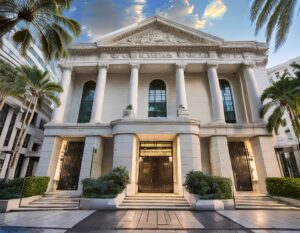Page Contents
- Overview
- Miami’s Retail Market Dynamics
- Market Pricing and Investment Trends
- Miami’s Economic Growth and Job Market
- Finance and Insurance Sector Trends
- Leisure and Hospitality Sector Performance
- Growth in Miami’s Tech Sector
- Office Sector and Economic Recovery
- Population Dynamics and Housing Market
- Miami’s Startup Ecosystem and Future Prospects
- A Beacon of Growth and Opportunity
Overview
- Stable Vacancy Rate: The Miami retail market has shown resilience with a stable vacancy rate of 3.0% over the past year, experiencing only a minor decrease of 0.1% from the previous year.
- Space Absorption vs. Delivery: There has been a positive balance between supply and demand, evidenced by the absorption of 900,000 square feet of retail space and the delivery of 770,000 square feet within the same period.
- Rising Retail Rents: Retail rents in Miami have increased significantly, now averaging at $44.00 per square foot, representing a 4.9% rise from the previous year and a cumulative increase of 14.9% over the past three years.
- Expansion of Inventory: About 3.2 million square feet of retail space is currently under construction, indicating a notable expansion of the existing inventory by 2.2%.
- Market Sales and Price Increase: The market has recorded 440 sales in the past year, with the market sale price reaching $433 per square foot, substantially surpassing the three-year average of $400 per square foot.
- Economic Growth Indicators: Supporting the robust market dynamics, Miami has experienced significant economic growth, with employment rising by 4.1% and the population growing by 1.3% over the last year.
Miami’s Retail Market Dynamics
 The retail market in Miami, one of the largest in the United States, has seen robust activity, with 444 retail transactions completed in the past year. This level of deal flow is consistent with the average observed over the past five years. The annual sales volume in the Miami retail sector has maintained an average of $1.5 billion, reaching a 12-month peak of $3.1 billion during this period. In the last year alone, investors sold retail assets worth $2.0 billion. General retail transactions have been the primary driver of this volume, contributing $1.4 billion to the metro area’s total in the past 12 months.
The retail market in Miami, one of the largest in the United States, has seen robust activity, with 444 retail transactions completed in the past year. This level of deal flow is consistent with the average observed over the past five years. The annual sales volume in the Miami retail sector has maintained an average of $1.5 billion, reaching a 12-month peak of $3.1 billion during this period. In the last year alone, investors sold retail assets worth $2.0 billion. General retail transactions have been the primary driver of this volume, contributing $1.4 billion to the metro area’s total in the past 12 months.
Market Pricing and Investment Trends
Market pricing in Miami’s retail sector currently stands at an impressive $433 per square foot, surpassing last year’s figures and significantly exceeding the national average. This places Miami among the top 1% of U.S. retail markets in terms of pricing. Additionally, the market capitalization rate (cap rate) has fallen to 5.3%, the lowest in the past five years for Miami, and remains structurally lower than the national average. This decrease in cap rate reflects a high valuation and investor confidence in the Miami retail market.
Miami’s Economic Growth and Job Market
In 2022, Miami experienced significant economic growth, fueled by healthy in-migration and a robust tourism sector that benefited from increased consumer spending on travel and dining out. The city’s annual job growth rate of 5% surpassed the U.S. average of 3.4%, led by gains in restaurants, retail trade, and ambulatory healthcare sectors. Oxford Economics predicts that Miami will see an average job growth rate of 0.8% from 2024 to 2027, outpacing the projected U.S. rate of 0.6%. From Q1 2020 to Q4 2022, Miami’s net job change was 3.3%, higher than the U.S. net growth of 1.6%. Additionally, Miami’s real GDP grew by 2.8% in 2022, more than the U.S. growth of 1.0%, with real estate and professional and technical services leading this growth.
Finance and Insurance Sector Trends
During the pandemic, Miami attracted numerous banks and securities firms, including prominent names like Citadel, GMC Capital, Melvin Capital, and the tech venture capital firm Andreessen Horowitz. The broader finance and insurance sector experienced a job growth of 5.7% and a real GDP growth of 1.7% in 2022. However, Oxford Economics forecasts a deceleration in this growth, predicting an average annual growth rate of 0.5% from 2023 to 2027, with a real GDP growth of 1.3% over the next five years.
Leisure and Hospitality Sector Performance
Miami’s substantial leisure and hospitality sector, boosted by the return of visitors to its renowned Art Basel fair, saw a 9% increase in job growth in 2022. Despite a contraction in real GDP growth in this sector, Oxford Economics forecasts an annual job growth of 1.9% and an average real GDP growth of 1.4% from 2023 through 2027.
Growth in Miami’s Tech Sector
The tech sector in Miami witnessed a remarkable job growth of 11% in 2022, along with a real GDP growth of 12.6% in information services. However, Oxford Economics projects a more subdued future, with average annual job gains remaining muted and real GDP growth expected to be around 1.9% from 2023 to 2027, reflecting softer conditions in the tech labor market in the near term.
Office Sector and Economic Recovery
Office-using sectors have been a highlight in Miami’s economic recovery. Employment in professional and business services and financial activities sectors is well above pre-pandemic levels. Major firms like Microsoft, Blackstone, CI Financial, and Millennium Management have leased significant office spaces in Miami, expected to add hundreds of high-paying jobs when fully staffed. In 2022, the office sector in Miami saw a job growth of 7.5%, and Oxford Economics predicts an average annual growth of 0.56% in office jobs from 2023 to 2027.
Population Dynamics and Housing Market
 Due to domestic outmigration, Miami-Dade County experienced minimal population growth from July 2021 through July 2022. However, a recovery in international net migration, with over 39,000 residents, helped offset the loss of over 38,000 domestic residents during this period. Miami continues to be a preferred destination for immigrants from South and Central America, with expected net in-migration of over 37,000 from 2023 to 2027 and an annual population growth rate of 0.55%, higher than the U.S. rate of 0.47%. Miami home values have increased by over 56% since 2019, outpacing the U.S. average but trailing Florida’s average. Oxford Economics projects a 9.6% decrease in the house price index in 2023, followed by a 5.4% increase in 2024. Despite traditionally low average wages, Miami saw a real wage increase of 3.4% from 2019 through 2022, surpassing the U.S. growth of 0.6%.
Due to domestic outmigration, Miami-Dade County experienced minimal population growth from July 2021 through July 2022. However, a recovery in international net migration, with over 39,000 residents, helped offset the loss of over 38,000 domestic residents during this period. Miami continues to be a preferred destination for immigrants from South and Central America, with expected net in-migration of over 37,000 from 2023 to 2027 and an annual population growth rate of 0.55%, higher than the U.S. rate of 0.47%. Miami home values have increased by over 56% since 2019, outpacing the U.S. average but trailing Florida’s average. Oxford Economics projects a 9.6% decrease in the house price index in 2023, followed by a 5.4% increase in 2024. Despite traditionally low average wages, Miami saw a real wage increase of 3.4% from 2019 through 2022, surpassing the U.S. growth of 0.6%.
Miami’s Startup Ecosystem and Future Prospects
Miami’s burgeoning startup ecosystem, supported by solid in-migration, a leading higher education system, and a competitive tax structure, is poised to continue driving job growth. In 2022, Miami ranked 31st in Startup Genome’s Global Startup Ecosystem, improving nine spots from the previous year. Japanese conglomerate SoftBank has been a significant venture capital contributor, investing over $250 million in Miami-based startups since 2021. With the addition of more than 20 venture capital funds during the pandemic, Miami’s pro-business and risk-friendly atmosphere positions it for continued growth in the startup sector.
A Beacon of Growth and Opportunity
In summary, Miami’s retail market and broader economic landscape present a vibrant picture of growth and opportunity. The retail sector, with its stable vacancy rates, increasing rents, and high market pricing, reflects the city’s strong demand and investor confidence. The finance and insurance sectors, along with the burgeoning tech industry, have experienced significant growth, attracting major firms and venture capital investments. The success of events like Art Basel showcases how Miami’s thriving leisure and hospitality sector further bolsters the city’s economic dynamism.
The city’s robust job market, led by diverse sectors such as health care, professional services, and leisure, outpaces national growth rates. Miami’s office sector, revitalized by significant leases from major firms, indicates a promising outlook for employment opportunities. Though challenged by domestic outmigration, the population dynamics are compensated by substantial international in-migration, particularly from South and Central America. While facing near-term adjustments, the housing market continues to show strong long-term growth potential. Finally, Miami’s evolving startup ecosystem, supported by a favorable business climate and strategic investments, is setting the stage for sustained economic expansion and innovation. This multifaceted growth positions Miami not just as a key player in the U.S. economy but as a global hub for business and investment.
If you’re considering an investment in commercial real estate, Lumicre is your go-to expert. Our dedicated team offers comprehensive support and insights to help you navigate the complexities of the market. Whether you’re a first-time investor or a seasoned professional, Lumicre provides tailored solutions to meet your unique investment goals. Contact us today to explore your commercial real estate investment opportunities and take the next step toward a successful venture in this dynamic field.